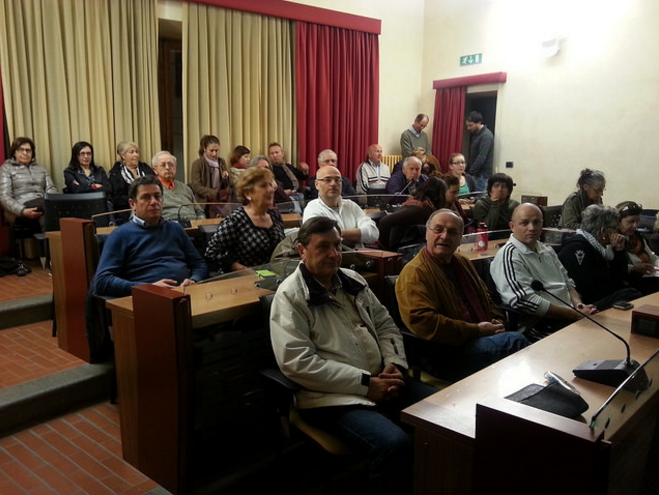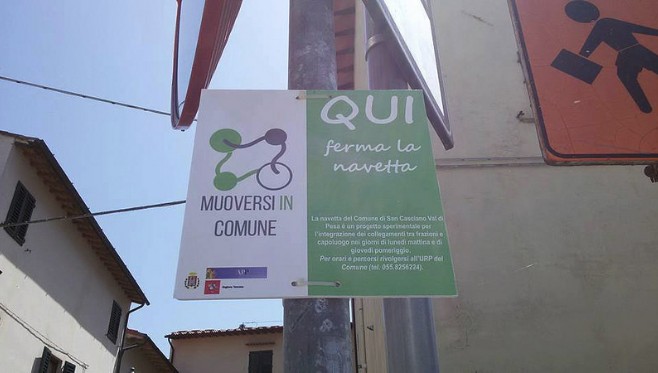The Municipality of San Casciano, with the support of the Authority for Participation of the Region of Tuscany, promoted the participatory process “Community Mobility Network” aimed at addressing directly some critical issues about mobility in the municipality.
Municipality of San Casciano Val di Pesa
Italy
The process “Community Mobility Network” focused on the definition and participatory design of an innovative and integrated public transport network. More specifically, the process focused on engaging citizens and different local actors of the territory in order to integrate the existing network of urban transport with shared solutions targeting both the development of new services and the introduction of innovations in the system local mobility.
The process was aimed at not only addressing the pressing issue of transport connections, but also at looking at the issue of accessibility in a wider sense as a tool to combat exclusion and promote social well-being and quality of life.
The process “Community Mobility Network” targeted the entire population and involved citizens as well as local organizations. The process actively involved approximately 500 people (3% of the population). The participation of particularly vulnerable groups with respect to the issue of the right to mobility (youth, elderly, disabled) was guaranteed through the involvement of associations and informal groups in the area.
Accessibility, in the sense of the concrete and effective possibility of accessing the workplace, social services, health centers, educational spaces, but also cultural and recreational facilities is a fundamental component in the fight against social exclusion, a discriminating factor in the promotion of social well-being and quality of life. In this context, public and private transports can present high barriers to entry: timetables, routes and costs may preclude their use, especially among the most vulnerable and less autonomous sectors of the population.
The City Council of San Casciano - which has been suffering in recent years from repeated cuts at the central and regional level to the financial resources needed to provide adequate public transportation - decided to share with its citizens not only the investment choices in new services but also -to actively involve the local community and key stakeholders in the participatory design of an innovative integrated mobility network.
The Municipality of San Casciano, with the support of the Authority for Participation of the Region of Tuscany, promoted the participatory process “Community Mobility Network” aimed at addressing directly some of these critical issues, highlighted by citizens themselves in the course of a previous experience in participatory budgeting. In particular, local residents stressed the weaknesses of the connections between the center and the periphery, which made it difficult for households to access basic services and prevented many residents living on the outskirts of the municipality to benefit from municipal initiatives and programs.
Step 1: Coordination and context analysis: joint fact finding and the creation of a shared wealth of information on the topic, essential to make process design more effective and to identify efficient actions in the community network development (activities included: mapping of existing services; interviews with key informants; meetings with local organizations).
Step 2: Engagement and needs assessment: Local resources (individuals and organizations) were engaged to develop proposals for the development of the mobility network (activities included: focus groups with stakeholders, associations, administrators; sharing of best practices in shared mobility; a network analysis survey on mobility in the local context).
Step 3: Participatory workshops and network strengthening Participatory workshops to allow citizens to express their views and share recommendations for co-designing innovative mobility solutions, based on existing best-practices and on the needs emerged through the survey and other context analysis tools (3 workshops in peripheral locations; 2 workshops in the central area)
Communication and information were cross-cutting and developed throughout the entire process and included a series of presentation events, a dedicated online section on the Regional platform for open government and participation (http://opentoscana.it); a Facebook page; postcards and posters distributed widely throughout the municipality.
Much of the communication supports were designed and disseminated through the involvement of citizens and local stakeholders, to ensure inclusion of all the actors involved.
The process “Community Mobility Network” lasted from March 2015 to July 2016. In the month of June 2016 a free shuttle service connecting the outskirts with the centre and designed through the process was activated, message boards for carpooling were installed throughout the city and activities promoting the practice of private car sharing were launched in several areas.

The process “Community Mobility Network” was promoted by the Municipality of San Casciano and supported financially by the Municipal Authority for Participation of the Region of Tuscany, a regional body established by law to support and promote inclusive decision-making processes.
The process was supported by the following internal organizational structure:
Technical staff:
Leonardo Baldini, coordinator of the project; Barbara Bagni, Financial Services.
Councillors:
Elisabetta Masti, Mobility Councillor; Donatella Viviani, Vice-Mayor.
Members of the Municipal Council that accompanied the activities: Duccio Becattini, Davide Borghi, Letizia Giuliani, Niccolò Landi, Sandro Matteini, Luna Piazzini, Beniamino Tripodi.Local voluntary associations which participated in all meetings and activities:
Maria Pia Leoncini, ANTEAS; Gianfranco Ciuffi, AUSER; Mario Piccini, Misericordia di Mercatale; Manuela Dini, Centro Socio Culturale Cerbaia; Alessandro Milanesi, Misericordia di San Casciano.
Representatives of the outskirts villages cultural centres:
Luca Piazzini, associazione LA CIURMA; Lorenzo Barubiani, Circolo Arci Cerbaia; Moreno Cheli, Circolo Ricreativo Chiesanuova; Elisa Pucci, referente di frazione a Chiesanuova; Massimo Cerretelli, Proloco Mercatale; Marina Carmassi, Circolo Ricreativo Montefiridolfi; Ferdinando Maida, Associazione Montefiridolfi; Spartaco Casini; Circolo Arci Romola; Silvia Turci, Circolo Mcl Romola; Nico Gronchi, Circolo Ricreativo Casa Del Combattente S.Pancrazio.
Experts in participatory methodologies: Sociolab scarl, a cooperative with extensive experience in planning and management of participatory processes.
Given the specificity of the topic, the staff was supported also by an expert in the field of alternative mobility, with particular reference to the use of web platforms and innovative solutions that do not necessarily involve the use of the web, and who illustrated best practices and existing solutions.
The process “Community Mobility Network” aimed to engage the entire population and involved citizens as well as local organizations in the co-design of a mobility network, promoting a new concept of sustainable mobility through the creation of an innovative community mobility, where actions by the community towards a more sustainable and effective mobility integrate the system of solutions set in place by the public sector, contributing to make it more dense and extensive and to matching more closely the needs of citizens.
Inclusive participation of the most vulnerable groups (youth, elderly, disabled) was guaranteed through prompt and continuous involvement of associations and informal groups active in the area. Local human resources within the Municipality were made a central part of the process, to ensure its ownership.
All activities were designed and implemented with the support of participatory experts and facilitators, to ensure inclusiveness, equal expression of all points of view and constructive dialogue to define shared recommendations for actions.

The process “Community Mobility Network” was funded by the Authority for participation of the Region of Tuscany (public entity) with co-funding from the Municipality of San Casciano Val di Pesa.
The City of San Casciano additionally funded the launch of a shuttle connecting the center with the peripheries with a Municipal investment of € 15,675 for the year 2016 and of €. 27,500 for the year 2017.
Since the beginning of the project, a series of communication and information activities were implemented to allow for the maximum involvement of the population, with particular attention to the most vulnerable groups (youth groups, the elderly, women, the disabled).
All the main web communication channels were activated (facebook, twitter) and a special section dedicated to the process was created on the regional online platform Open Toscana (http://opentoscana.it)
All communication material used accessible language and provided key information and facts to familiarize citizens with the issue of mobility and the innovations developed in the field, not always known or commonly practiced in the local context.
A simple and coordinated visual identity was used in all communication and information materials (cards, leaflets, posters, presentations, report, website, social networks, etc.).

Each activity was documented with a synthetic report highlighting the main topics addressed and solutions identified. All reports were immediately shared online and with all process participants.
Dissemination activities included presentation events and final report drafting, with particular reference to the testing of the shuttle; to the strengthening of the local network of actors engaged in social transportation activities and to the installation of message boards for carpooling. Six participants from different areas of the Municipality volunteered to become referents and key persons for the carpooling initiative.
The process “Community Mobility Network” targeted the entire population and involved citizens as well as local organizations. The process actively involved approximately 500 people (3% of the population). The participation of particularly vulnerable groups with respect to the issue of the right to mobility (youth, elderly, disabled) was guaranteed through the involvement of associations and informal groups in the area.
Participants divided into:
STAKEHOLDERS of organizations and institutions;
MUNICIPAL STAFF AND LOCAL COUNCILLORS involved support the process internally.
CITIZENS involved through interviews, focus groups, co-design workshops and a survey on mobility.
Process documentation tools:
Webpage on the online platform Open Toscana:
http://open.toscana.it/web/community-mobility-network
Facebook page: https://www.facebook.com/muoversiincomune
Page on the municipal website: http://www.sancascianovp.net/trasporti-viabilita-e-polizia-municipale/item/2578-servizio-navetta-gratuito
Photo album on FLICKR: https://www.flickr.com/gp/sociolab/pTU5Ph

At the end of the process, the main results can be synthesized in an immediate and effective strengthening of the periphery-center connection through the implementation of a co-designed free shuttle service, available two days a week and currently used by the most vulnerable sectors of the population (elderly, youth groups, disabled).
At the end of the process, the main results can be synthesized as follows:
Testing of a system of sharing of private mobility through carpooling, through the establishment of message boards to share lifts among individuals in remote areas. All message boards were set up by the Municipality but are managed by local residents.
The process “Community Mobility Network” was developed in the area of San Casciano Val di Pesa, but it represents a significant pilot experience for the regional area as a whole. Although territorially limited to San Casciano, the project has a high potential for replication in neighbouring municipalities of the Chianti Fiorentino area, and in the country as a whole.
The outcomes of the workshops and of the questionnaires designed by the Regional Authority for Participation and disseminated throughout the project, allowed to carry out an initial assessment of the results according to parameters such as their level of satisfaction with the process, the perceived impact of the participants contribution to the decision-making process, the quantity and quality of the participatory activities, the quantity and quality of the information and communication activities, the inclusiveness of the process, its relevance to citizens' priorities.
The City Council will carry out participatory assessments of shuttle service and of the shared mobility experiences developed through the process.
Taking as its starting point the critical need transport service integration, and for strengthening the network of organizations providing social transport services, the process “Community Mobility Network” allowed to achieve in a short time and effectively 3 objectives which are at the heart of the international debate on the future of mobility:
Additional information and photo documentation can be found at the following links:
Photo album on FLICKR: https://www.flickr.com/gp/sociolab/pTU5Ph
Webpage on the online platform Open Toscana: http://open.toscana.it/web/community-mobility-network
Facebook page: https://www.facebook.com/muoversiincomune
Page on the municipal website: http://www.sancascianovp.net/trasporti-viabilita-e-polizia-municipale/item/2578-servizio-navetta-gratuito
“Participatory design of an innovative and integrated public transport network, innovative integrated mobility network. This is an innovative, participatory way to improve public services. “